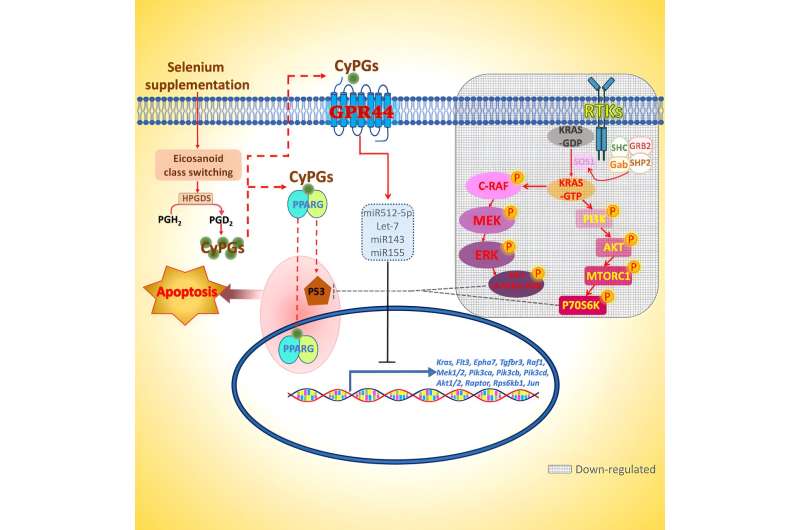This article has been reviewed according to Science X's editorial process and policies. Editors have highlighted the following attributes while ensuring the content's credibility:
fact-checked
peer-reviewed publication
trusted source
proofread
Dietary selenium may help fight acute myeloid leukemia, researchers report

Selenium-enriched diets may help ward off myeloid leukemia, and a new study led by researchers in Penn State's College of Agricultural Sciences has described the mechanism by which this occurs.
The findings, published in Cell Reports, eventually could help lead to drug therapies that target some types of leukemia—including acute myeloid leukemia (AML), the most common blood and bone marrow cancer in adults, the researchers said.
Penn State scientists previously found that supplementing the diets of mice with selenium—a trace mineral naturally found in varying amounts in many foods—stimulated the production of compounds known as cyclopentenone prostaglandins, which appeared to kill or suppress leukemia stem cells.
Their latest study shows that these prostaglandins, called CyPGs, bind to and activate a gene, GPR44. That gene encodes a G-protein-coupled receptor, which is a protein on a cell membrane that transmits signals from extracellular substances. When expressed on leukemia stem cells, this receptor signals the cells to undergo programmed death.
"The GPR44 receptor is not well understood," said study co-author Robert Paulson, professor of veterinary and biomedical sciences. "It has been described as helping certain immune cells function and helping to regulate what's known as type two immune responses. But the work we did describes a totally novel function. We came from the prostaglandin side—that the prostaglandin seemed to be able to induce cell death in leukemia stem cells. And now we've shown that it works through GPR44."
AML is characterized by the proliferation of abnormal, leukemia-initiating stem cells in the bone marrow, blood and other tissues, explained lead author Sandeep Prabhu, professor of immunology and molecular toxicology and head of the Department of Veterinary and Biomedical Sciences.
"Treating acute myeloid leukemia is challenging because of these persistent, leukemia-initiating stem cells, which are typically not targeted by most existing therapies," Prabhu said. "As a result, relapse of the disease is a big concern."
Leukemia-initiating stem cells resemble normal blood-forming stem cells, he noted, adding that alternative therapies that selectively target leukemic stem cells could open new avenues to treat acute myeloid leukemia and other malignancies.
To test the hypothesis that GPR44 plays a role in the selenium-induced death of leukemia stem cells, the research team transplanted leukemic stem cells from mice that were devoid of GPR44 to mice whose cells had the GPR44 receptor. Groups of these mice had been fed diets with varying amounts of selenium supplementation prior to the transplants. The team then observed whether and how fast the disease progressed in the various groups.
"We had shown previously that if we supplement mice with selenium or we give them the CyPGs, we can treat their leukemia—make it less aggressive or even basically cure it," Paulson said. "We wanted to understand the mechanism of how that worked, and in this study, we tested it by getting rid of the GPR44 receptor to see what would happen without the receptor."
The result was that the mice with the GPR44 receptor receiving selenium supplementation had significantly better outcomes than the ones in which the receptor was deleted.
"In mice that lack the receptor, the leukemia becomes extremely aggressive—it's like taking the brakes away," Prabhu said.
He pointed out that while CyPGs induced leukemia stem cell death, they had no impact on normal blood-forming stem cells in the bone marrow, potentially making this a safe treatment regimen that also may help ensure the recovery of normal blood cell formation during leukemia.
Paulson noted that the presence of GPR44 for the expression of this receptor on leukemia cells could be a biomarker for the aggressiveness of leukemia and for whether a patient's cells will respond to prostaglandin and potential related therapies.
"We think we have a good target now for developing therapies," he said. "When you test a new therapy, some patients would never respond to your drug because they just don't have the right receptors. And now that we know that this receptor is key, we can tailor our tests with patient samples and target ones that we think will respond. That way, it's more likely that we'll identify a subset of leukemias that would be responsive to this kind of therapy."
The researchers are working with faculty in Penn State's College of Medicine to validate their findings, with the hope of proceeding to clinical trials with leukemia patients. They credited the contributions of collaborators—including scientists in the College of Medicine, colleagues in the Department of Veterinary and Biomedical Sciences, and graduate and undergraduate students—for the success of the study.
More information: Fenghua Qian et al, Activation of GPR44 decreases severity of myeloid leukemia via specific targeting of leukemia initiating stem cells, Cell Reports (2023). DOI: 10.1016/j.celrep.2023.112794
















